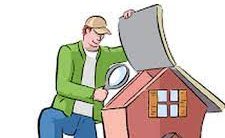By Mark J. Caffiers
Director ~ D.S. Murphy Inspections
dsmurphyinspections.com
Concerns regarding indoor air quality have risen significantly over the few years. We constantly hear new studies regarding toxins, which are, emitted from everything in a home from paint to plastics to carpeting. Homes are becoming more efficient, better insulated and more tightly sealed. One of the newest barometers to measure home efficiency is the HERS rating (Home Energy Rating System). One main test is called a Blower Door Test. Basically, a blower door is a very powerful fan that is fixed into the frame of an exterior door. When turned on, the fan pulls all the air out of the house and lowers the air pressure inside. This results in the higher outside air pressure flowing into the house through any unsealed cracks and openings, revealing the air infiltration rate of the home and showing where an air leak may be hiding. Our homes are getting tighter and tighter. That is not entirely good.
The larger looming issue is a deadly invisible gas, which has no odor and exists in all our homes. Radon is a naturally occurring radioactive gas that been on earth from the outset. Radon gas decays into radioactive particles that become trapped in your lung tissue as you breathe. As they break down further these particles continue to release bursts of energy further damaging lung tissue and can lead to lung cancer over the course of your lifetime. The Surgeon General has warned that radon is the second leading cause of lung cancer in the United States today. Only smoking causes more lung cancer deaths. You cannot see smell or taste radon but there is some level of it everywhere. The amount that is normally found in the outside air is 0.4 pCi/L and average indoors radon levels are estimated to be about 1.3 pCi/L. These levels fluctuate greatly depending on geology and soil conditions. The threshold for remediation in homes is 4.0pCi/l. What do these numbers mean and at what level it dangerous? Accessing radon levels requires technical knowledge and special skills learned through a professional course of study. It also takes expensive equipment to accurately read current levels.
Radon, like other radioactive materials, is measured in pCi/L. This stands for pico Curies per liter of air. A “pico Curie” is one-trillionth of a Curie, which is the unit that defines the amount of radioactive decays of 1 gram of radium also equivalent to 37 billion radioactive disintegrations per second. Therefore, one pico-Curie works out to 2.2 radioactive disintegrations per minute (dpm) in a liter of air. A “Curie” is named after the famed Nobel winning scientist Marie Curie who discovered radium in 1898 and coined the term radioactivity. Radon is part of the Uranium decay chain shown depicted here.

Radon gas is the first decay product of Radium, which is a solid. In just under 4 days, each radon gas atom decays 5 times these radioactive disintegrations take on three different forms, Alpha radiation, Beta radiation and Gamma radiation. The result of a “disintegration” is it changes into new element each time … Radon ~ 218Polonium ~214Lead ~214Bismuth~214Polunium ~210Lead which has a much longer half-life of 22.3 years it eventually becomes ~206Lead which is stable 22 ½ years later. However, in this metamorphosis it releases energy as Alpha, Beta or Gamma. While these releases of energy are extremely small, they have the potential to damage cells and DNA possibly beginning the formation of mutant or cancerous cells. Since uranium is one of the most common radioactive elements on earth and it’s isotopes have very long half-lives, billions of years, Radon will always be present long into the future as it is constantly being produced by nature. So there will always be Radon gas and there will always be some risk associated with exposure since there is no safe level.
Sounds scary right? It is alarming if this is the first time you realize the danger. Through our course of study to become proficient radon measurement technicians and analytical service providers, we have learned a great deal about Radon and felt compelled to share that information in a manner that is easy to understand and increases awareness.
You are probably thinking is there any way to rid my home of Radon? The answer is no not completely. Radon is a serious health issue but it can only be minimized. The risk can be reduced by testing for radon and lowering the radon level in your home. It is very inexpensive to test for and measure the radon concentration in your house. It largest impact is houses with basements as well as houses built on slabs. Houses with crawl spaces should be tested as well. Condominiums on ground floors (slab foundation) as well townhouses with either basements or built on slabs should be tested too. Radon levels can vary due to seasonal effects, weather, wind direction and speed. Testing once does not guarantee that your levels will always be low. This is why the EPA recommends that homes should be tested for Radon every two years, due to radon levels fluctuating constantly due to natural cycles.
Radon gas can be mitigated to safer levels established by the EPA. You can minimize its pathways to your home and help ensure a healthier and safer environment. You should not delay testing because you are afraid of finding out the results. In the case of radon, WHAT YOU DON’T KNOW CAN HURT YOU. We encourage home buyers and owners to test for Radon. Use an inspection company, which does not mitigate so they are not motivated to find elevated readings.
For more complete information you can find “A Citizen’s Guide To Radon The Guide To Protecting Yourself And Your Family From Radon “ published by the EPA here…
https://www.epa.gov/sites/production/files/2016-12/documents/2016_a_citizens_guide_to_radon.pdf
For more information I can be reached at 678-573-6010 or mcaffiers@dsmurphyinspections.com

